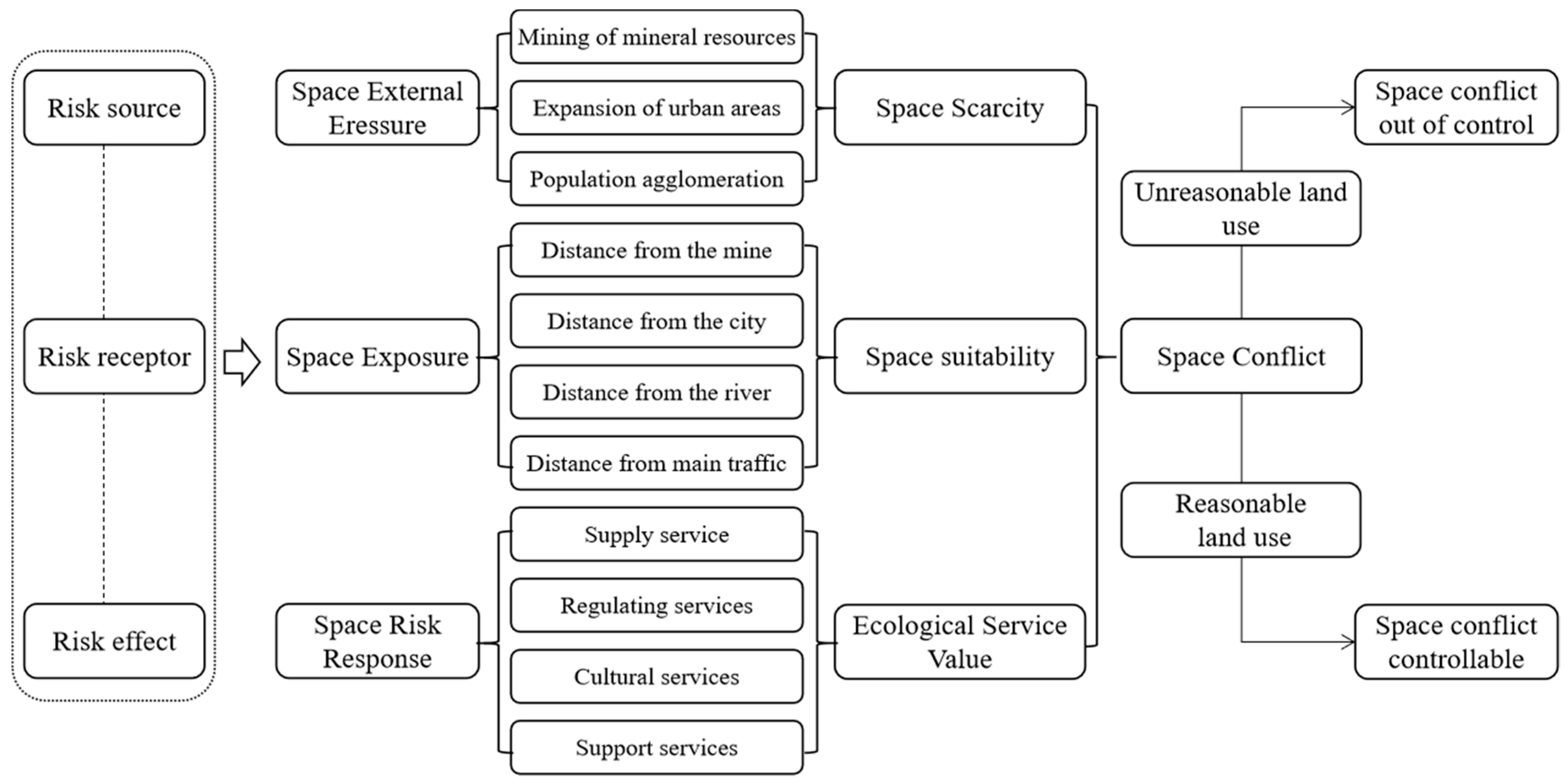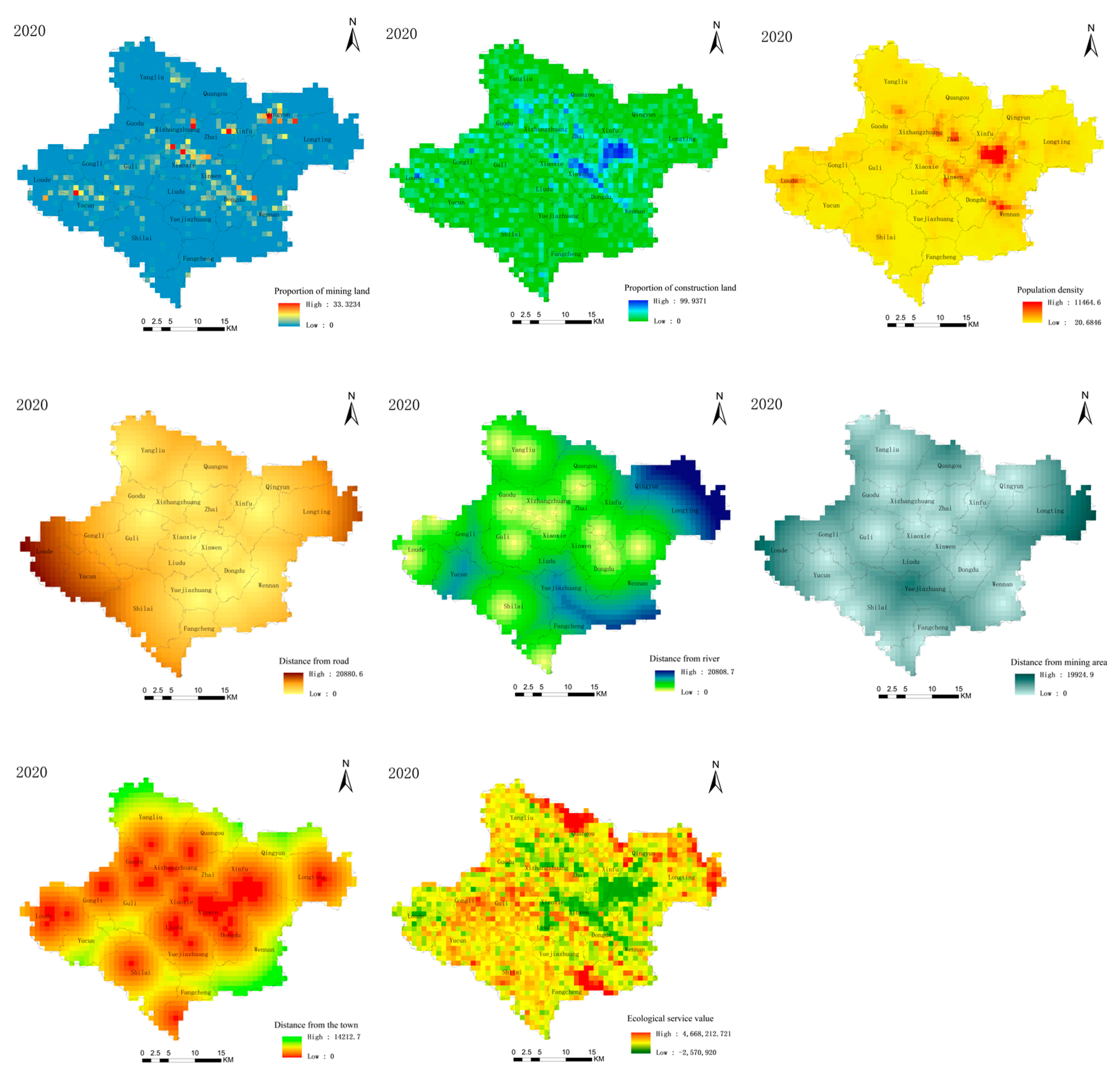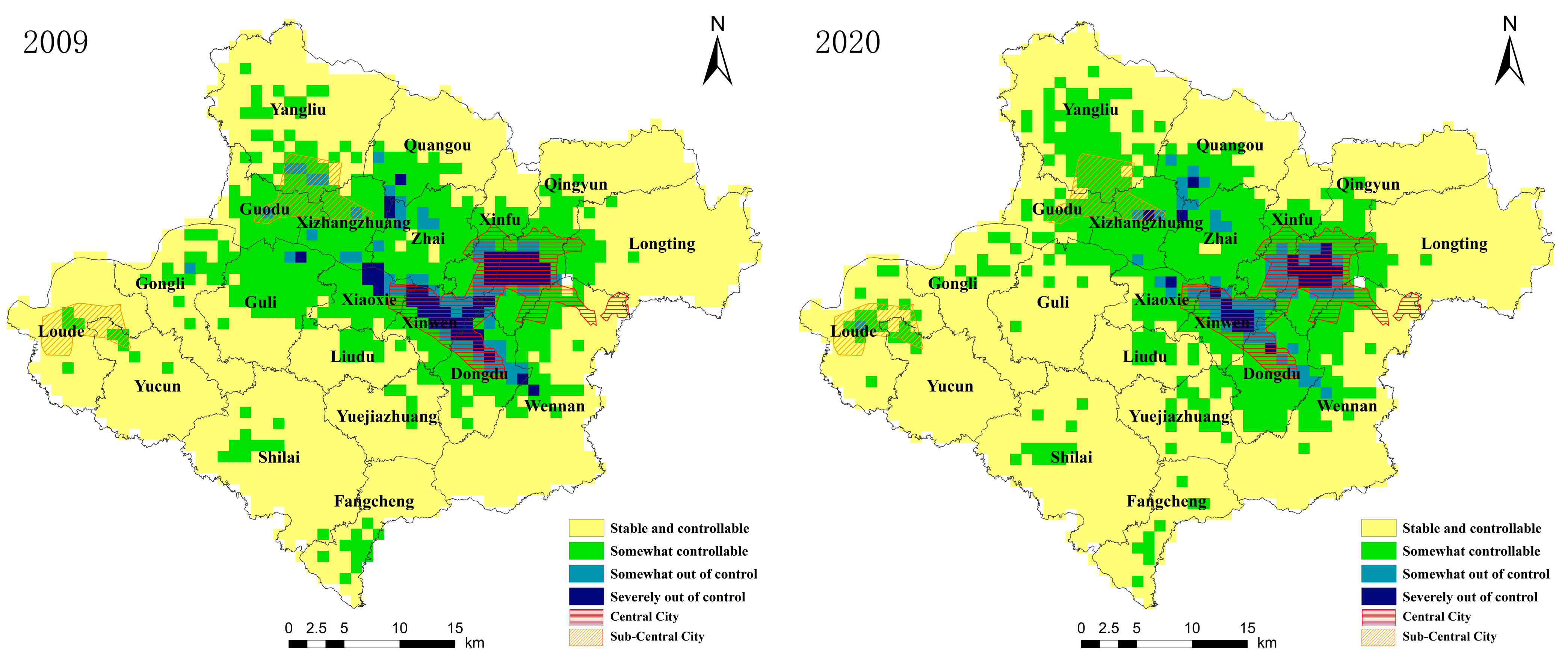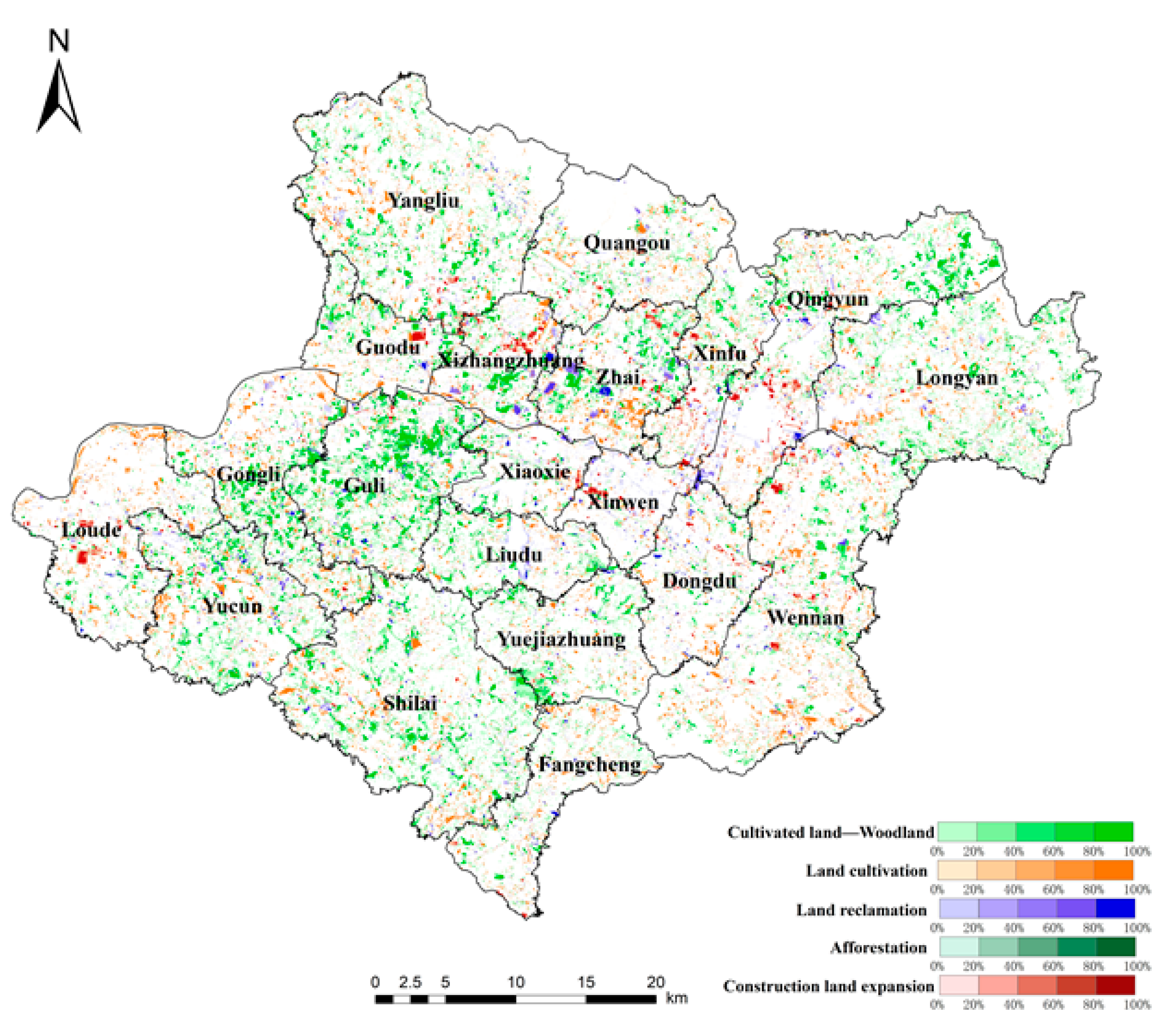Measuring the Spatial Conflict of Resource-Based Cities and Its Coupling Coordination Relationship with Land Use
Abstract
:1. Introduction
2. Construction of the Spatial Conflict Measurement Model
3. Materials and Methods
3.1. Study Area
3.2. Data Sources
3.3. Method
3.3.1. Spatial Conflict Index
3.3.2. Dynamic Degree of Land Use
3.3.3. The Coupling Coordination Model
4. Results
4.1. Spatial and Temporal Evolution Characteristics of Spatial Conflicts
4.2. Dynamic Degree of Land Use
4.3. Degree of Coupling Coordination
5. Discussion
5.1. Measurement of Spatial Conflict Based on Ecological Service Value
5.2. The Changes in Land Use
5.3. The Changes in Land Use and Spatial Conflict
5.4. Limitations
6. Conclusions
- (1)
- From 2009 to 2020, the change in the spatial conflict index in Xintai was relatively stable, with a change of 0.0018 (Table 2). The changing trend of different conflict levels is different. The number of stable and controllable and somewhat out of control grid cells increased by 20 and 90, respectively, and the number of somewhat controllable and severely out of control grid cells decreased by 84 and 26, respectively. In terms of space, the spatial conflict pattern of Xintai is distributed in circles, with high intensity in the middle and relatively low intensity in the surrounding areas. Moreover, the areas with strong spatial conflicts have good spatial consistency with the urban areas and mining areas.
- (2)
- From 2009 to 2020, affected by the demand for urban transformation, the changes in land use in Xintai had significant spatial differences, with the dynamic degree of land use being [0–0.73], and the average dynamic degree of land use was 23.14% (Table 3). There are obvious differences in the mutual transformation among different land types, mainly including the shift from cultivated land to woodland, land reclamation, land restoration, afforestation, and the expansion of construction land.
- (3)
- From 2009 to 2020, the land use patterns and spatial conflict in Xintai were mainly coordinated, with 1065 units, accounting for 60.20%, and 704 units, accounting for 39.80% (Table 4). The weakened areas of spatial conflict were dominated by coordination, with 774 units, accounting for 43.75%, while the areas of enhanced spatial conflict were dominated by incoordination, with 579 units, accounting for 32.73%. Further analysis showed that the land use of Xintai mainly serves the regional development position and the land management of the mining area, and coordination between the land use and the management of spatial conflict needs to be improved.
Author Contributions
Funding
Institutional Review Board Statement
Informed Consent Statement
Data Availability Statement
Conflicts of Interest
References
- Zhang, W.; Wang, D.; Yu, J. Study on the Development Path and Pattern of Substituted Industry in Resource-Based Cities. Bull. Chin. Acad. Sci. 2011, 26, 134–141. [Google Scholar]
- Tan, J.; Zhang, P.; Lo, K.; Li, J.; Liu, S. The Urban Transition Performance of Resource-Based Cities in Northeast China. Sustainability 2016, 8, 1022. [Google Scholar] [CrossRef]
- Long, R.; Li, H.; Wu, M.; Li, W. Dynamic Evaluation of the Green Development Level of China’s Coal-Resource-Based Cities Using the TOPSIS Method. Resour. Policy 2021, 74, 102415. [Google Scholar] [CrossRef]
- Zhou, G.; Peng, J. The Evolution Characteristics and Influence Effect of Spatial Conflict: A Case Study of Changsha-Zhuzhou-Xiangtan Urban Agglomeration. Prog. Geogr. 2012, 31, 717–723. [Google Scholar]
- Zhou, D.; Xu, J.; Wang, L. Land Use Spatial Conflicts and Complexity: A Case Study of the Urban Agglomeration around Hangzhou Bay, China. Geogr. Res. 2015, 34, 1630–1642. [Google Scholar]
- Lin, G.; Jiang, D.; Fu, J.; Cao, C.; Zhang, D. Spatial Conflict of Production-Living-Ecological Space and Sustainable-Development Scenario Simulation in Yangtze River Delta Agglomerations. Sustainability 2020, 12, 2175. [Google Scholar] [CrossRef]
- Almeida, J.; Costa, C.; Nunes da Silva, F. A Framework for Conflict Analysis in Spatial Planning for Tourism. Tour. Manag. Perspect. 2017, 24, 94–106. [Google Scholar] [CrossRef]
- Brown, G.; Raymond, C.M. Methods for Identifying Land Use Conflict Potential Using Participatory Mapping. Landsc. Urban Plan. 2014, 122, 196–208. [Google Scholar] [CrossRef]
- Evans, J.D.; Kirkpatrick, J.B.; Bridle, K.L. A Reciprocal Triangulation Process For Identifying And Mapping Potential Land Use Conflict. Environ. Manag. 2018, 62, 777–791. [Google Scholar] [CrossRef]
- Zhou, D.; Lin, Z.; Lim, S.H. Spatial Characteristics and Risk Factor Identification for Land Use Spatial Conflicts in a Rapid Urbanization Region in China. Environ. Monit. Assess. 2019, 191, 677. [Google Scholar] [CrossRef]
- Dong, G.; Ge, Y.; Jia, H.; Sun, C.; Pan, S. Land Use Multi-Suitability, Land Resource Scarcity and Diversity of Human Needs: A New Framework for Land Use Conflict Identification. Land 2021, 10, 1003. [Google Scholar] [CrossRef]
- He, Y.; Tang, C.; Zhou, G.; He, S.; Qiu, Y.; Shi, L.; Zhang, H. The Analysis of Spatial Conflict Measurement in FastUrbanization Region from the Perspective of Geography—A Case Study of Changsha-Zhuzhou-Xiangtan UrbanAgglomeration. J. Nat. Resour. 2014, 29, 1660–1674. [Google Scholar]
- Wang, J.; Zou, L.; Li, M. Identification and Governance of Potential Land Use Conflicts in Tourism Resort Based on Ecological-Production-Living Suitability. Nongye Gongcheng Xuebao/Trans. Chin. Soc. Agric. Eng. 2019, 35, 279–288. [Google Scholar]
- Lin, G.; Fu, J.; Jiang, D. Production-Living-Ecological Conflict Identification Using a Multiscale Integration Model Based on Spatial Suitability Analysis and Sustainable Development Evaluation: A Case Study of Ningbo, China. Land 2021, 10, 383. [Google Scholar] [CrossRef]
- Liu, X.; Zhang, Z.; Li, M.; Fu, Y.; Hui, Y. Spatial Conflict Simulation of Land-Use Based on Human-Land-Landscape Elements Intercoordination: A Case Study in Tianjin, China. Environ. Monit. Assess. 2022, 194, 317. [Google Scholar] [CrossRef]
- Cieślak, I. Identification of Areas Exposed to Land Use Conflict with the Use of Multiple-Criteria Decision-Making Methods. Land Use Policy 2019, 89, 104225. [Google Scholar] [CrossRef]
- Yun, L.; Yanfang, Z.; Mao, T.; Lichang, Y.; Ru, W. Identification of Key Ecological Protection Areas Based on the “Importance-Sensitivity-Conflict” Framework in Northern Shaanxi Province. Resour. Environ. Yangtze River Basin 2020, 29, 643–653. [Google Scholar]
- Zou, L.; Liu, Y.; Wang, J.; Yang, Y. An Analysis of Land Use Conflict Potentials Based on Ecological-Production-Living Function in the Southeast Coastal Area of China. Ecol. Indic. 2021, 122, 107297. [Google Scholar] [CrossRef]
- Cui, J.; Kong, X.; Chen, J.; Sun, J.; Zhu, Y. Spatially Explicit Evaluation and Driving Factor Identification of Land Use Conflict in Yangtze River Economic Belt. Land 2021, 10, 43. [Google Scholar] [CrossRef]
- Adam, Y.O.; Pretzsch, J.; Darr, D. Land Use Conflicts in Central Sudan: Perception and Local Coping Mechanisms. Land Use Policy 2015, 42, 1–6. [Google Scholar] [CrossRef]
- Zhao, X.; Tang, F.; Zhang, P.; Hu, B.; Xu, L. Dynamic Simulation and Characteristic Analysis of County Production-Living-Ecological Spatial Conflicts Based on CLUE-S Model. Shengtai Xuebao 2019, 39, 5897–5908. [Google Scholar]
- Zou, L.; Liu, Y.; Wang, J.; Yang, Y.; Wang, Y. Land Use Conflict Identification and Sustainable Development Scenario Simulation on China’s Southeast Coast. J. Clean. Prod. 2019, 238, 117899. [Google Scholar] [CrossRef]
- Reuveny, R.; Maxwell, J.W.; Davis, J. On Conflict over Natural Resources. Ecol. Econ. 2011, 70, 698–712. [Google Scholar] [CrossRef]
- Yu, F.; Ru-tian, B.; Jin, W.; Chunjuan, L.; Qianjuan, Z. Spatial Conflict of Land Use Caused by Mining Exploitation and Optimal Allocation Scheme of Land Resources in River Basin. China Land Sci. 2016, 30, 32–40. [Google Scholar]
- Jiang, S.; Meng, J.; Zhu, L. Spatial and Temporal Analyses of Potential Land Use Conflict under the Constraints of Water Resources in the Middle Reaches of the Heihe River. Land Use Policy 2020, 97, 104773. [Google Scholar] [CrossRef]
- Zong, S.; Hu, Y.; Zhang, Y.; Wang, W. Identification of Land Use Conflicts in China’s Coastal Zones: From the Perspective of Ecological Security. Ocean Coast. Manag. 2021, 213, 105841. [Google Scholar] [CrossRef]
- Zou, L.; Liu, Y.; Wang, Y. Research Progress and Prospect of Land-Use Conflicts in China. Prog. Geogr. 2020, 39, 298–309. [Google Scholar] [CrossRef]
- Li, S.; Zhu, C.; Lin, Y.; Dong, B.; Chen, B.; Si, B.; Li, Y.; Deng, X.; Gan, M.; Zhang, J.; et al. Conflicts between Agricultural and Ecological Functions and Their Driving Mechanisms in Agroforestry Ecotone Areas from the Perspective of Land Use Functions. J. Clean. Prod. 2021, 317, 128453. [Google Scholar] [CrossRef]
- Jiang, S.; Meng, J.; Zhu, L.; Cheng, H. Spatial-Temporal Pattern of Land Use Conflict in China and Its Multilevel Driving Mechanisms. Sci. Total Environ. 2021, 801, 149697. [Google Scholar] [CrossRef]
- Tudor, C.A.; Iojǎ, I.C.; Pǎtru-Stupariu, I.; Nitǎ, M.R.; Hersperger, A.M. How Successful Is the Resolution of Land-Use Conflicts? A Comparison of Cases from Switzerland and Romania. Appl. Geogr. 2014, 47, 125–136. [Google Scholar] [CrossRef]
- Meng, W.; Fengqi, Z.; Jin, C. Spatial Conflict Measurement in Rapid Urbanization Areas from the Perspective of Ecosystem Services. China Popul. Resour. Environ. 2021, 31, 12–20. [Google Scholar]
- Costanza, R.; Arge, R.; De Groot, R.; Farber, S.; Hannon, B.; Limburg, K.; Naeem, S.; Neill, R.V.O. The Value of the World’s Ecosystem Services and Natural Capital. Nature 1997, 387, 253–260. [Google Scholar] [CrossRef]
- Gaodi, X.; Caixia, Z.; Leiming, Z.; Wenhui, C.; Shimei, L. Improvement of the Evaluation Method for Ecosystem Service Value Based on Per Unit Area. J. Nat. Resour. 2015, 30, 1243–1254. [Google Scholar]
- Ran, H.; Xiangyang, X.; Junlian, G.; Tingting, Z.; Bo, L. Spatial Patterns of Ecosystem Services and Their Relationships with Residents’Well-Being of Coal Resource-Based Cities. Chin. J. Soil Sci. 2020, 51, 31–39. [Google Scholar]
- Li, F.; Zhang, S.; Bu, K.; Yang, J.; Wang, Q.; Chang, L. The Relationships between Land Use Change and Demographic Dynamics in Western Jilin Province. J. Geogr. Sci. 2015, 25, 617–636. [Google Scholar] [CrossRef]
- Huang, B.; Huang, J.; Gilmore Pontius, R.; Tu, Z. Comparison of Intensity Analysis and the Land Use Dynamic Degrees to Measure Land Changes Outside versus inside the Coastal Zone of Longhai, China. Ecol. Indic. 2018, 89, 336–347. [Google Scholar] [CrossRef]
- Pontius, R.G.; Huang, J.; Jiang, W.; Khallaghi, S.; Lin, Y.; Liu, J.; Quan, B.; Ye, S. Rules to Write Mathematics to Clarify Metrics Such as the Land Use Dynamic Degrees. Landsc. Ecol. 2017, 32, 2249–2260. [Google Scholar] [CrossRef]
- Yuan, J.; Bian, Z.; Yan, Q.; Pan, Y. Spatio-Temporal Distributions of the Land Use Effciency Coupling Coordination Degree in Mining Cities of Western China. Sustainability 2019, 11, 5288. [Google Scholar] [CrossRef]
- Ji, X.; Wang, K.; Ji, T.; Zhang, Y.; Wang, K. Coupling Analysis of Urban Land Use Benefits: A Case Study of Xiamen City. Land 2020, 9, 155. [Google Scholar] [CrossRef]
- Wang, P.; Qi, M.; Liang, Y.; Ling, X.; Song, Y. Examining the Relationship between Environmentally Friendly Land Use and Rural Revitalization Using a Coupling Analysis: A Case Study of Hainan Province, China. Sustainability 2019, 11, 6266. [Google Scholar] [CrossRef]
- Yang, C.; Zeng, W.; Yang, X. Coupling Coordination Evaluation and Sustainable Development Pattern of Geo-Ecological Environment and Urbanization in Chongqing Municipality, China. Sustain. Cities Soc. 2020, 61, 102271. [Google Scholar] [CrossRef]
- Jiajie, P.; Guohua, Z.; Chengli, T. The Analysis of Spatial Conflict Measurement in Fast Urbanization Region Based on Ecological Security—A Case Study of Changsha-Zhuzhou-Xiangtan Urban Agglomeration. J. Nat. Resour. 2012, 27, 1507–1519. [Google Scholar]







| Type | Arable Land | Garden | Woodland | Grassland | Construction Land | Water | Utilized Land | |
|---|---|---|---|---|---|---|---|---|
| Reconciliation services | Gas regulation | 1070.33 | 4602.40 | 7492.28 | 1712.52 | −5180.38 | −1626.89 | 0.00 |
| Climate regulation | 1905.18 | 3853.17 | 5779.76 | 1926.59 | 0.00 | 9397.46 | 0.00 | |
| Water harvesting | 1284.39 | 4281.30 | 6850.08 | 1712.52 | −16,076.29 | 11,163.49 | 64.22 | |
| Waste disposal | 3510.67 | 2804.25 | 2804.25 | 2804.25 | −5266.00 | 16,825.52 | 21.41 | |
| Support services | Soil formation and conservation | 3125.35 | 6261.40 | 8348.54 | 4174.27 | 42.81 | 920.48 | 42.81 |
| Biodiversity conservation | 1519.86 | 4655.92 | 6978.52 | 2333.31 | 727.82 | 2670.46 | 727.82 | |
| Supply services | Food production | 2140.65 | 428.13 | 214.07 | 642.20 | 21.41 | 214.07 | 21.41 |
| Raw materials | 214.07 | 2836.36 | 5565.69 | 107.03 | 0.00 | 42.81 | 2140.65 | |
| Cultural services | Entertainment and culture | 21.41 | 1412.83 | 2740.03 | 85.63 | 21.41 | 5292.76 | 21.41 |
| Total | 14,791.90 | 31,135.77 | 46,773.22 | 15,498.31 | −25,709.22 | 44,900.15 | 3039.72 | |
| Conflict Level | Threshold | 2009 | 2020 | Amount of Change | |||
|---|---|---|---|---|---|---|---|
| Grid Cells/pc | Percentage/% | Grid Cells/pc | Percentage/% | Grid Cells/pc | Percentage/% | ||
| Stable and controllable | [0, 0.5] | 1187 | 67.1 | 1207 | 68.23 | −20 | −1.13 |
| Somewhat controllable | (0.5, 0.7] | 477 | 26.96 | 393 | 22.22 | 84 | 4.74 |
| Somewhat out of control | (0.7, 0.8] | 56 | 3.17 | 146 | 8.25 | −90 | −5.08 |
| Severely out of control | (0.8, 1.0] | 49 | 2.77 | 23 | 1.3 | 26 | 1.47 |
| Index mean | 0.4544 | 0.4526 | 0.0018 | ||||
| Dynamic Degree of Land Use | Grids | Percentage/% |
|---|---|---|
| 0–15% | 215 | 12.15 |
| 15–30% | 1283 | 72.53 |
| 30–45% | 250 | 14.13 |
| 45–60% | 20 | 1.13 |
| 60–73.54% | 1 | 0.06 |
| Total | 1769 | 100.00 |
| Type | Coupling Coordination | Weakened Area/pc | Percentage/% | Enhanced Area/pc | Percentage/% | |
|---|---|---|---|---|---|---|
| Incoordination | Severe incoordination | 0.0—0.39 | 47 | 2.66 | 74 | 4.18 |
| Slight incoordination | 0.40—0.59 | 78 | 4.41 | 505 | 28.55 | |
| Subtotal | 125 | 7.07 | 579 | 32.73 | ||
| Coordination | Slight coordination | 0.60—0.79 | 303 | 17.13 | 124 | 7.01 |
| High coordination | 0.80—1.0 | 471 | 26.63 | 167 | 9.44 | |
| Subtotal | 774 | 43.75 | 291 | 16.45 | ||
| Total | 899 | 50.82 | 870 | 49.18 | ||
| Type | Enhanced Area/km2 | Weakened Area/km2 | Difference |
|---|---|---|---|
| Land reclamation | 55.00 | 49.97 | 5.03 |
| Land restoration | 13.25 | 28.58 | −15.34 |
| Expansion of construction land | 30.39 | 23.14 | 7.26 |
| Cultivated land to woodland | 87.66 | 139.51 | −51.85 |
| Afforestation | 23.42 | 29.18 | −5.76 |
Publisher’s Note: MDPI stays neutral with regard to jurisdictional claims in published maps and institutional affiliations. |
© 2022 by the authors. Licensee MDPI, Basel, Switzerland. This article is an open access article distributed under the terms and conditions of the Creative Commons Attribution (CC BY) license (https://creativecommons.org/licenses/by/4.0/).
Share and Cite
Zheng, Y.; Cheng, L.; Wang, Y. Measuring the Spatial Conflict of Resource-Based Cities and Its Coupling Coordination Relationship with Land Use. Land 2022, 11, 1460. https://doi.org/10.3390/land11091460
Zheng Y, Cheng L, Wang Y. Measuring the Spatial Conflict of Resource-Based Cities and Its Coupling Coordination Relationship with Land Use. Land. 2022; 11(9):1460. https://doi.org/10.3390/land11091460
Chicago/Turabian StyleZheng, Yang, Linlin Cheng, and Yifang Wang. 2022. "Measuring the Spatial Conflict of Resource-Based Cities and Its Coupling Coordination Relationship with Land Use" Land 11, no. 9: 1460. https://doi.org/10.3390/land11091460
APA StyleZheng, Y., Cheng, L., & Wang, Y. (2022). Measuring the Spatial Conflict of Resource-Based Cities and Its Coupling Coordination Relationship with Land Use. Land, 11(9), 1460. https://doi.org/10.3390/land11091460







